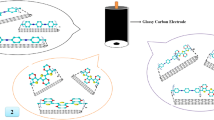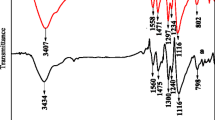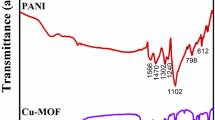Abstract
Polyaniline (PANI)/copper oxide (CuO), poly(3,4-ethylenedioxythiophene) (PEDOT)/CuO and polypyrrole (PPy)/CuO have been synthesized electrochemically on glassy carbon electrode in sodium dodecyl sulfate in sulfuric acid solution as an electroactive material. To our best knowledge, the first report on comparison of supercapacitor behaviors of PANI/CuO, PEDOT/CuO and PPy/CuO nanocomposite films was studied by electrochemical impedance spectroscopy, related to the plots of Nyquist, Bode magnitude and Bode phase. The highest specific capacitance (C sp) was obtained as C sp = 286.35 F × g−1 at the scan rate of 20 mV × s−1 for PANI/CuO amongst the PEDOT/CuO (C sp = 198.89 F × g−1 at 5 mV × s−1) and PPy/CuO (C sp = 20.78 F × g−1 at 5 mV × s−1) by CV method. Long-term stability of the capacitor has also been tested by CV method, and the results indicated that, after 500 cycles, the specific capacitance of PANI/CuO nanocomposite film is 81.82 % of the initial capacitance. An equivalent circuit model of R s(C dl(R 1(Q(R 2 W)))) has been used to fit the experimental and theoretical data.








Similar content being viewed by others
References
Kim SY, Lee KH, Chin BD, Yu JW (2009) Network structure organic photovoltaic devices prepared by electrochemical copolymerization. Sol Energy Mater Sol Cells 93(1):129–135
Kasama D, Takata R, Kajii H, Ohmori Y (2009) Optical property of poly(9,9-dioctylfluorene) gel with β phase and application to polymer light emitting diode. Thin Solid Films 518(2):559–562
Ciobotaru IC, Matei E, Ciobotaru CC, Polosan S (2014) Embedding of IrQ(ppy)(2) or organometallic compounds in polypyrrole conducting polymer for OLED’s applications. Synth Met 198:323–328
Inzelt G, Pineri M, Schultze JW, Vorotyntsev MA (2000) Electron and proton conducting polymers: recent developments and prospects. Electrochim Acta 45(15–16):2403–2421
Yeh JM, Chen CL, Chen YC, Ma CY, Lee KR, Wei Y, Li S (2002) Enhancement of corrosion protection effect of poly(0-ethoxyaniline) via the formation of poly(o-ethoxyaniline)-clay nanocomposite materials. Polymer 43(9):2729–2736
He H, Zhu J, Tao NJ, Nagahara LA, Amlani I, Tusi R (2001) A conducting polymer nanojunction switch. J Am Chem Soc 123(31):7730–7731
Frackowiak E, Khomenko V, Jurewicz K, Lota K, B´Eguin F (2006) Supercapacitors based on conducting polymers/nanotubes composites. J Power Sources 153(2):413–418
Ates M, Uludag N, Karazehir T (2012) Copolymer formation of 9-(2 (benzyloxy) ethyl)-9H-carbazole and 1-tosyl-1H-pyrrole coated on glassy carbon electrode and electrochemical impedance spectroscopy. J Solid State Electrochem 16(8):2639–2649
Chen HY, Hou JH, Zhang SQ, Liang YY, Yang GW, Yang Y, Yu LP, Wu Y, Li G (2009) Polymer solar cells with enhanced open-circuit voltage and efficient. Nat Photonics 3(11):649–653
Lipomi DJ, Bao ZA (2011) Stretchable, elastic materials and devices for solar energy conversion. Energy Environ Sci 4(9):3314–3328
Sasabe H, Takamatsu J, Motoyama T, Watanabe S, Wagenblast G, Langer N, Molt O, Fuchs E, Lennartz C, Kido J (2010) High-efficiency blue and white organic light-emitting devices incorporating a blue iridium carbene complex. Adv Mater 22(44):5003–5007
Kim FS, Ren GQ, Jenekhe SA (2011) One-dimensional nanostructures of pi-conjugated molecular systems: assembly, properties, and applications from photovoltaics, sensors, and nanophotonics to nanoelectronics. Chem Mater 23:682–732
Mastragostino M, Arbizzani C, Soavi F (2002) Conducting polymers as electrode materials in supercapacitors. Solid State Ionics 148(3–4):493–498
Guimard NK, Gomez N, Schmidt CE (2007) Conducting polymers in biomedical engineering. Prog Polym Sci 32(8–9):876–921
Ates M, Uludag N, Karazehir T (2012) Electrolyte effects of poly(3-methylthiohene) via PET/ITO and synthesis of 5-(3,6-di(thiophene-2-yl)-9H-carbazole-9-yl) pentanitrile on electrochemical impedance spectroscopy. J Appl Polym Sci 125(4):3302–3312
Arbizzani C, Mastragostino M, Meneghello L, Paraventi R (1996) Electronically conducting polymers and activated carbon: electrode materials in supercapacitor technology. Adv Mater 8(4):331–334
Mastragostino M, Paraventi R, Zanelli A (2000) Supercapacitors based on composite polymer electrodes. J Electrochem Soc 147(9):3167–3170
Snook GA, Kao P, Best AS (2011) Conducting polymer based supercapacitor devices and electrodes. J Power Sources 196(1):1–12
Ramya R, Sivasubramanian R, Sangaranarayanan MV (2013) Conducting polymers-based electrochemical supercapacitors-Progress and prospects. Electrochim Acta 101:109–129
Pan L, Qiu H, Dou C, Li Y, Pu L, Xu J, Shi Y (2010) Conducting polymer nanostructures: template synthesis and applications in energy storage. Int J Mol Sci 11:2636–2657
Li D, Huang JX, Li D, Kaner RB (2009) Polyaniline nanofibers: a unique polymer nanostructure for versatile applications. Acc Chem Res 42(1):135–145
Tran HD, Li D, Kaner RB (2009) One-dimensional conducting polymer nanostructures: bulk synthesis and applications. Adv Mater 21(14–15):1487–1499
Barsoukov E, Macdonald JR (2005) Impedance spectroscopy: theory, experiment, and applications. In: (ed) Hoboken, Wiley-Interscience, New York, pp 121
Lang G, Inzelt G (1999) An advanced model of the impedance of polymer film electrodes. Electrochim Acta 44:2037–2051
Ma R, Bando Y, Zhang L, Sasaki T (2004) Layered MnO2 nanobelts: hydrothermal synthesis and electrochemical measurements. Adv Mater 16(11):918–922
Bisquert J, Garcia-Belmonte G, Fabregat-Santiago F, Ferriols NS, Bogdanoff P, Pereira EC (2000) Doubling exponent models for the analysis of porous film electrodes by impedance. Relaxation of TiO2 nanoporous in aqueous solution. J Phys Chem B 104(10):2287–2298
Wu MS, Huang YA, Yang CH, Jow JJ (2007) Electrodeposition of nanoporous nickel oxide film for electrochemical capacitors. Int J Hydrogen Energy 32(17):4153–4159
Wahdame B, Candusso D, Francois X, Harel F, Kauffmann JM, Coquery G (2009) Design of experiment techniques for fuel cell characterization and development. Int J Hydrogen Energy 34(2):967–980
Sen P, De A (2010) Electrochemical performances of poly(3,4-ethylenedioxythiophene)-NiFe(2)O(4) nanocomposite as electrode for supercapacitor. Electrochem Acta 55(16):4677–4684
Liu C, Ma LP, Cheng HM (2010) Advanced materials for energy storage. Adv Mater 22(8):E28–E62
Dhibar S, Sahoo S, Das CK (2013) Fabrication of transition-metal-doped polypyrrole/multiwalled carbon nanotubes nanocomposites for supercapacitor applications. J Appl Polym Sci 130:554–562
Aradilla D, Estrany F, Alemán C (2011) Symmetric supercapacitors based on multilayers of conducting polymers. J Phys Chem C 115(16):8430–8438
Dubal DP, Dhawale DS, Salunkhe RR, Jamdade VS, Lokhande CD (2005) Fabrication of copper oxide multilayer nanosheets for supercapacitor application. J Alloy Compd 492:26–30
Xu YY, Chen DR, Jiao XL (2005) Fabrication of CuO pricky microspheres with tunable size by a simple solution route. J Phys Chem B 109:13561–13566
Jundale DM, Navale ST, Khuspe GD, Dalavi DS, Patil PS, Patil VB (2013) Polyaniline–CuO hybrid nanocomposites: synthesis, structural, morphological, optical and electrical transport studies. J Mater Sci Mater Electron 24:3526–3535
Dubal VD, Dhawale DS, Salunkhe RR, Jamdade VS, Lokhande CD (2010) Fabrication of copper oxide multilayer nanosheets for supercapacitors application. J Alloys Compd 492:26–30
Patake VD, Joshi SS, Lokhande CD, Joo OS (2009) Electrodeposited porous and amorphous copper oxide film for application in supercapacitor. Mater Chem Phys 114:6–9
Pendashteh A, Mousavi MF, Rahmanifar MS (2013) Fabrication of anchored copper oxide nanoparticles on graphene oxide nanosheets via an electrostatic coprecipitation and its application as supercapacitor. Electrochim Acta 88:347–357
Sharma P, Bhatti TS (2010) A review on electrochemical double-layer capacitors. Energy Convers Manag 51(12):2901–2912
Kumar A, Singh RK, Singh HK, Srivastava P, Singh R (2014) Enhanced capacitance and stability of p-toluenesulfonate doped polypyrrole/carbon composite for electrode application in electrochemical capacitors. J Power Sources 246:800–807
Fiordiponti P, Pistoia G (1989) An impedance study of polyaniline films in aqueous and organic solutions. Electrochim Acta 34(2):215–221
Guler FG, Gilsing HD, Schulz B, Sarac AS (2012) Impedance and morphology of hydroxy- and chloro-functionalized poly(3,4-propylenedioxythiophene) nanostructures. J Nanosci Nanotechnol 12(10):7869–7878
Sarac AS, Gilsing HD, Gencturk A, Schulz B (2007) Electrochemically polymerized 2,2-dimethyl-3,4-propylenedioxythiohene on carbon fiber for microsupercapacitor. Prog Org Coat 60(4):281–286
Qian D, Dickey EC, Andrews R, Rantell T (2000) Load transfer and deformation mechanisms in carbon nanotube-polystyrene composites. Appl Phys Lett 76(20):2868–2870
Shi SL, Zhang LZ, Li JS (2009) Electrical and dielectric properties of multiwall carbon nanotube/polyaniline composites. J Polym Res 16(4):395–399
Urquidimacdonald M, Real S, Macdonald DD (1990) Applications of Kramers–Kronig transform in the analysis of electrochemical impedance data 3. Stability and linearity. Electrochim Acta 35(10):1559–1566
Acknowledgments
The financial support from Namik Kemal University, Tekirdag, Turkey, project number: NKUBAP.00.10.AR.14.11 is gratefully acknowledged. Authors thank Serhat Tıkız (Afyon Kocatepe Uni., TUAM, Afyon, Turkey) for recording SEM measurements. Authors also thank Dr. Argun Gokceoren (ITU, Istanbul, Turkey) for FTIR-ATR measurements.
Conflict of interest
Authors must disclose all relationships or interests that could have direct or potential influence or impart bias on the work. Although an author may not feel there is any conflict, disclosure of relationships and interests provides a more complete and transparent process, leading to an accurate and objective assessment of the work. Awareness of a real or perceived conflicts of interest is a perspective to which the readers are entitled. There is not meant to imply that a financial relationship with an organization that sponsored the research or compensation received for consultancy work is appropriate. Examples of potential conflicts of interests that are directly or indirectly related to the research may include but are not limited to the following: research grants from funding agencies (Project Number: NKUBAP.00.10.AR.14.11).
Author information
Authors and Affiliations
Corresponding author
Rights and permissions
About this article
Cite this article
Ates, M., Serin, M.A., Ekmen, I. et al. Supercapacitor behaviors of polyaniline/CuO, polypyrrole/CuO and PEDOT/CuO nanocomposites. Polym. Bull. 72, 2573–2589 (2015). https://doi.org/10.1007/s00289-015-1422-4
Received:
Revised:
Accepted:
Published:
Issue Date:
DOI: https://doi.org/10.1007/s00289-015-1422-4




